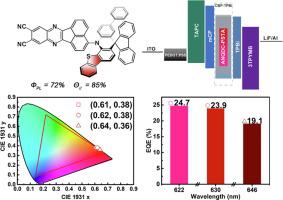Chemical Engineering Journal ( IF 13.3 ) Pub Date : 2020-08-15 , DOI: 10.1016/j.cej.2020.126663 Xu Gong , Chen-Han Lu , Wei-Kai Lee , Pan Li , Yu-Hsin Huang , Zhanxiang Chen , Lisi Zhan , Chung-Chih Wu , Shaolong Gong , Chuluo Yang

|
Red thermally activated delayed fluorescence (TADF) emitters underperform their blue and green counterparts, largely due to their low photoluminescence quantum efficiency and isotropic orientation. Here, we designed two rigid and strong electron-rich donor moieties, 3-methyl-13H-spiro[benzo[4,5]thieno[3,2-c]acridine-5,9′-fluorene] (MSTA) and 3-phenyl-13H-spiro[benzo[4,5]thieno[3,2-c]acridine-5,9′-fluorene] (PSTA), by fusing benzothiophene unit on a spiro-acridine framework. Combined with a rigid, linear, and planar acenaphtho[1,2-b]quinoxaline-9,10-dicarbonitrile (ANQDC) acceptor, two red emitters, ANQDC-MSTA and ANQDC-PSTA, were synthesized and characterized. In virtue of high rigidity and linear donor–acceptor (D-A) molecular skeleton, both emitters showed distinct TADF nature, high photoluminescence quantum efficiencies and high horizontal ratios of emitting dipole orientation of ≈85%. Consequently, the ANQDC-PSTA-based OLEDs realized high external quantum efficiency (EQE) of 24.7% at an electroluminescence peak (ELpeak) of 622 nm, together with Commission Internationale de l’Eclairage 1931 (CIE1931) coordinates of (0.61, 0.38). Furthermore, with the modulation of the microcavity effect on the device architecture, we delivered a 19.1% EQE in a deep-red EL region, with an ELpeak of 646 nm and favorable CIE1931 coordinates of (0.64, 0.36). These efficiencies are on par with the highest EL performance for red TADF OLEDs in the similar color gamut.
中文翻译:

基于苯并噻吩稠合的螺iro啶供体的高效红色热活化延迟荧光发射体
红色的热激活延迟荧光(TADF)发射器的性能不如蓝色和绿色,主要是由于它们的低光致发光量子效率和各向同性取向。在这里,我们设计了两个刚性和强电子富集的供体部分,3-甲基-13 H-螺[苯并[4,5]噻吩并[3,2-c] ac啶-5,9'-芴](MSTA)和通过在螺-啶骨架上融合苯并噻吩单元,将3-苯基-13 H-螺[苯并[4,5]噻吩并[3,2-c] ac啶-5,9'-芴](PSTA)。与刚性,线性和平面[1,2-b]喹喔啉-9,10-二甲腈(ANQDC)受体,两个红色发射体ANQDC-MSTA和ANQDC-PSTA结合使用合成和表征。由于具有高刚性和线性的供体-受体(DA)分子骨架,两个发射器都显示出独特的TADF性质,高的光致发光量子效率和较高的发射偶极子定向取向比率(≈85%)。因此,基于ANQDC-PSTA的OLED在622 nm的电致发光峰(EL峰)处实现了24.7%的高外部量子效率(EQE),以及国际照明委员会1931年(CIE1931)坐标为(0.61、0.38 )。此外,随着微腔效应对器件架构的调节,我们在深红色EL区域提供了19.1%的EQE,并且具有EL峰波长为646 nm,CIE1931坐标为(0.64,0.36)。这些效率与色域相同的红色TADF OLED的EL性能最高。




















































 京公网安备 11010802027423号
京公网安备 11010802027423号